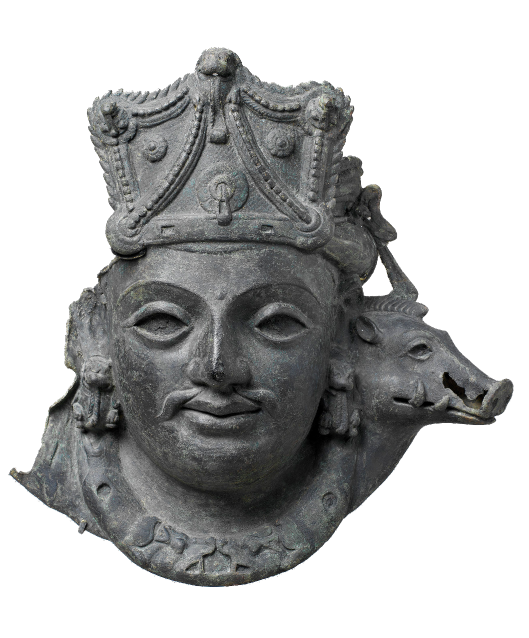ARTICLE
Avukana Buddha
A monumental relief sculpture of a standing Buddha dated between the fifth and eighth centuries CE, the Avukana Buddha statue is carved from a granite rock face in Avukana (or Aukana) in the North Central Province of Sri Lanka. It is an early example of the colossal Buddha statue in the Sri Lankan sculptural tradition, thought to express the concept of Lokottora — the transcendent or supramundane being of the Buddha — in Mahayana Buddhist theology.
Discovery and dating
Harry Charles Purvis Bell, the first archaeological commissioner of British-ruled Ceylon (now Sri Lanka), discovered the Avukana Buddha during excavations in Anuradhapura district in 1895. Remains of stone walls at the site suggest that a pillared shrine or patimaghara (image-house) measuring around 15 x 6 metres enclosed the sculpture. Bricks excavated at the site, including wedge-shaped ones, suggest that the upper sections of the walls would have been built in brick, with a vaulted roof covering the chamber, though the head was probably visible from outside. Two large entrance portals on the eastern side faced the statue, leading to an internal aisle that allowed worshippers to circulate along the front and sides of the statue.
Like other Sri Lankan Buddha colossi, the Avukana statue faces a large body of water, in this case Kalaveva, an artificial water reservoir complex developed by the Moriya king Dhatusena (r. 455–73 CE) that harnessed water from the Kala Oya river system, allowing agriculture and trade to flourish in the region. While some scholars initially dated the sculpture to the twelfth or thirteenth century, others, including the archaeologist Senarath Paranavithana, insisted on a much earlier date of the fifth century, partly based on the assumption that it was built in the same period as the reservoir. Brahmi inscriptions at a group of caves in Avukana show that activity at the site predates the reservoir, though this may not include the construction of the statue.
Similarities with Buddha sculptures made during a period of Buddhist revival in Amaravati, southern India, under the reign of the Eastern Chalukyas, have led some scholars to infer a dating of seventh–twelfth centuries. In 1952, a mason working on the conservation of the statue discovered an eighth-century Sinhalese inscription on the northern wall of the shrine. While some scholars retained their argument for a fifth-century origin for the Avukana Buddha, suggesting that the shrine was built later, the general consensus is that it was produced at some time between the fifth and eighth centuries. The size and sophistication of the sculpture suggest it was commissioned by a wealthy, most likely royal patron.
Visual features
Standing on a double-lotus pedestal a little under a metre tall, the Avukana Buddha rises to a height of a little over 13 metres. The statue is carved in high relief, with a good portion of it detached from the rock face; the head is carved fully in the round. The Buddha is depicted in the samabhanga pose — standing upright, perfectly balanced on both feet. The eyes, brows, nose and lips, as well as the short curly hair, are sharply defined; the eyes are half-closed eyes as if in deep meditation. He is shown with elongated earlobes to indicate the heavy earrings he would have worn as the prince Siddhartha Gautama. The ushnisha — the ovoid cranial protuberance on the crown of his head that signifies enlightenment in Buddhist iconography — topped with a carved flame (siras-pota or siraspata) comprises a modern addition to the sculpture. The Buddha wears a monastic robe (uttarasanga) draped over his left shoulder and extending down to his ankles, with the cloth pleated across his body. His left hand is held up towards his body, gathering the drape, with the back of his hand facing outward. His right hand is held up in a gesture of granting blessings known as asisa in Sinhalese iconography — the hand is held up straight, close to the shoulder, with the palm facing left; the gesture appears similar to the abhaya mudra in Indian art, in which the palm faces the viewer.
Stylistic influences
Buddhism was first introduced to the Anuradhapura Kingdom by the Maurya emperor Ashoka (r. 268–232 BCE); this was followed by cultural exchanges with the Buddhist centre of Magadha (in present-day Bihar in northeastern India). Sinhalese monks and pilgrims made frequent visits to Bodh Gaya and other major Buddhist sites in the Magadha region, which remained active under Gupta rule (fourth to seventh centuries CE). Sri Lankan Buddhist art also drew inspiration from the sculptural tradition of Amaravati in erstwhile Andhradesa (roughly corresponding to present-day Andhra Pradesh in southern India), an important Buddhist site since the third century BCE. Amaravati had experienced a revival of Buddhist art under the reign of the Eastern Chalukyas (seventh to twelfth centuries CE), with its artists in turn influenced by earlier Gupta Buddha images. Excavations in Amaravati have revealed statues of the Buddha dated between the eighth and tenth centuries CE that bear stylistic resemblance to the Avukana Buddha; likewise, foreign-made limestone Buddha statues typical of the Andhradesa region have been excavated in Sri Lanka.
The Avukana Buddha’s mudras, heavy build and rigidly frontal pose resemble Buddha images in the Amaravati style; the bulging fold of his robe near the ankle is also characteristic of Amaravati Buddhas. However, the body’s proportions and detailing appear to be more Gupta-derived — the shoulders are wider than the hips, the facial features are finished with sharp, well-defined edges and the pleated drape of the robe is shown with finely rendered orderly lines; the contours of the body and the undergarment are clearly indicated, creating the effect of a clinging drape.
Relics and significance
The pedestal was carved separately and pushed underneath the figure; a natural indent in the rock face under the pedestal forms a squarish chamber, discovered in 1952 during conservation by the Sri Lankan Department of Archaeology. Within the chamber, conservators found five small bronze sculptures of Brahmanical deities — Brahma in the centre, surrounded by Indra, Kubera, Yama and Varuna, respectively placed in the four cardinal directions. Scholars believe this arrangement of the deities within the lotus symbolises the manifest universe; the Buddha standing above represents the doctrine of Lokottara or transcendence which emerged from the Mahasanghika sect of Buddhism and was later adopted by Mahayana Buddhism.
Later examples of such colossal Buddhas are seen at the Gal Vihara monastery in the North Central Province, and others in Uva Province. Similar massive rock relief Buddha sculptures are also seen in Central Asia, China, and other parts of South Asia, of which the Bamiyan Buddhas were among the best known. In recent years, the Avukana Buddha site has been renovated and more facilities have been added by Sri Lanka’s Civil Security Force and the Department of Archaeology. At the time of writing, the Avukana Buddha is a popular tourist destination and continues to be worshipped by Buddhist pilgrims from across the world.
Bibliography
Brancaccio, Pia. “Monumental Rock-cut Images from Sri Lanka: New Perspectives.” In Bridging Heaven and Earth: Art and Architecture in South Asia; Proceedings of the EASAA Conference 2016, vol. 2, edited by L. R. Greaves and A. Hardy. Delhi: Dev Publishers, 2020.
Dohanian, Diran K. “The Colossal Buddha at Aukana.” Archives of the Chinese Art Society of America 19 (1965): 16–25. http://www.jstor.org/stable/20067080.
Padmanabha, K. “A Note on the Buddha Images of Ceylon and Nepal.” The Tibet Journal 24, no. 2 (1999): 108–11. http://www.jstor.org/stable/43302427.
Perera, Harshini. “A New Facelift to Avukana Precincts.” Sunday Observer, June 21, 2009. Accessed November 30, 2023. https://web.archive.org/web/20160303235636/http://www.sundayobserver.lk/2009/06/21/spe02.asp.
Snellgrove, David L., ed. The Image of the Buddha. Paris: UNESCO, 1978.






